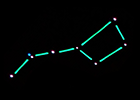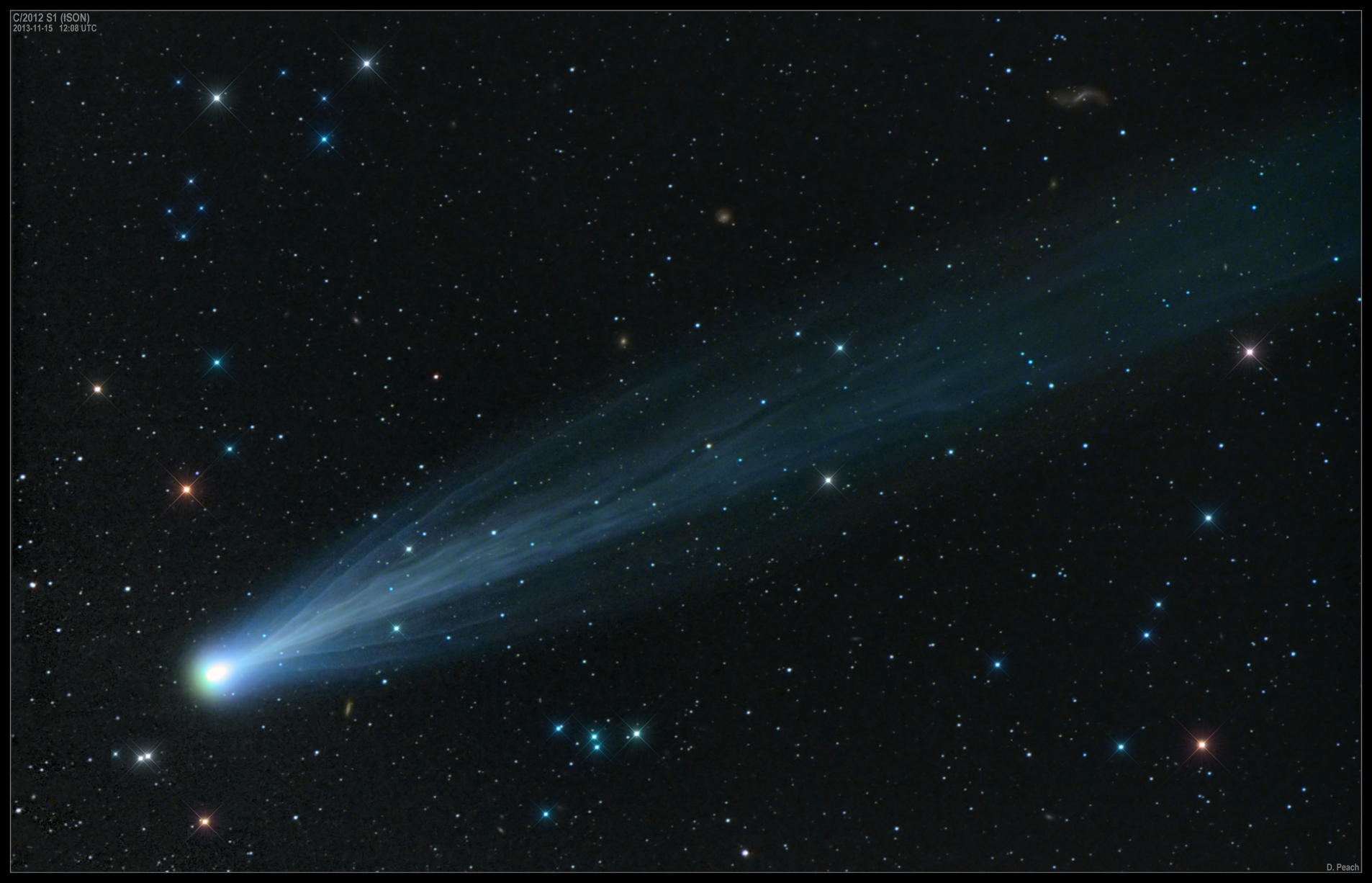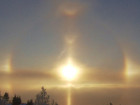|
Comets thread
|
|
| HarbingerDawn | Date: Thursday, 14.11.2013, 04:25 | Message # 166 |
 Cosmic Curator
Group: Administrators
 United States
United States
Messages: 8717
Status: Offline
| Quote Darkcloak (  ) Can anybody explain why those images turned out the way they did?
Can you be specific as to which images you're referring to? There were two separate Hubble ISON images that I recall, and each has its own story.
All forum users, please read this!
My SE mods and addons
Phenom II X6 1090T 3.2 GHz, 16 GB DDR3 RAM, GTX 970 3584 MB VRAM
|
| |
| |
| Watsisname | Date: Thursday, 14.11.2013, 21:36 | Message # 167 |
 Galaxy Architect
Group: Global Moderators
 United States
United States
Messages: 2613
Status: Offline
| ISON continues to brighten along the predicted (post-SD-event) curve, and in the last day or two has reached the limit of naked eye visibility (magnitude ~6).

|
| |
| |
| Fireinthehole- | Date: Thursday, 14.11.2013, 23:40 | Message # 168 |
 Pioneer
Group: Translators
 Sweden
Sweden
Messages: 365
Status: Offline
| Quote Watsisname (  ) ISON continues to brighten along the predicted (post-SD-event) curve, and in the last day or two has reached the limit of naked eye visibility (magnitude ~6).
Great! But how bright will it be? I haven't seen a comet bright enough for the naked eye since Hale-Bopp 
Love Space Engine!

|
| |
| |
| HarbingerDawn | Date: Friday, 15.11.2013, 01:04 | Message # 169 |
 Cosmic Curator
Group: Administrators
 United States
United States
Messages: 8717
Status: Offline
| I wish I could remember Hale-Bopp  Hopefully ISON will give a nice show. Hopefully ISON will give a nice show.
All forum users, please read this!
My SE mods and addons
Phenom II X6 1090T 3.2 GHz, 16 GB DDR3 RAM, GTX 970 3584 MB VRAM
|
| |
| |
| HarbingerDawn | Date: Friday, 15.11.2013, 23:52 | Message # 170 |
 Cosmic Curator
Group: Administrators
 United States
United States
Messages: 8717
Status: Offline
| Spectacular ISON photo by Damian Peach

All forum users, please read this!
My SE mods and addons
Phenom II X6 1090T 3.2 GHz, 16 GB DDR3 RAM, GTX 970 3584 MB VRAM
|
| |
| |
| Watsisname | Date: Saturday, 16.11.2013, 00:32 | Message # 171 |
 Galaxy Architect
Group: Global Moderators
 United States
United States
Messages: 2613
Status: Offline
| Such beautiful tail structure. 

|
| |
| |
| Salvo | Date: Saturday, 16.11.2013, 14:46 | Message # 172 |
 Star Engineer
Group: Local Moderators
 Italy
Italy
Messages: 1400
Status: Offline
| Quote HarbingerDawn (  ) Spectacular ISON photo by Damian Peach
W... ow, that's amazing!
I feel lost looking in that image, the stars behind, the tail of the comet, everything is awesome 
The universe is not required to be in perfect harmony with human ambition.
CPU: Intel Core i7 4770 GPU: ASUS Radeon R9 270 RAM: 8 GBs
(still don't know why everyone is doing this...)
Edited by Salvo - Saturday, 16.11.2013, 14:48 |
| |
| |
| Watsisname | Date: Monday, 18.11.2013, 08:25 | Message # 173 |
 Galaxy Architect
Group: Global Moderators
 United States
United States
Messages: 2613
Status: Offline
| Earlier in this thread, werdna asked if the Oort cloud would pose a risk to high-velocity spacecraft leaving the solar system. The answer 'not really' was given without much proof, but I recently got to thinking about it again and wanted to get a numerical answer. I was curious how much area of the sky is actually taken up by comets in the Oort cloud, if you added them all up. So here's a little math exercise and some interesting tidbits found out of it.
We don't really have a good model of comet size distribution or position, only some general estimates, so let's treat the Oort cloud as being of some number n of comets of typical radius rc and distance from the Sun, that is the average distance of the Oort cloud, RO. We will need to consider the total mass of the Oort cloud MO, and typical density of a comet ρ. Since the cloud is so diffusely populated, we may also ignore self-shadowing (no comets hiding behind other comets). If that was actually important, then, as midtskogen noted, it would dim the background stars.
So the ratio of solid angle taken up by comets to the whole sky is the solid angle of a comet times the number of comets divided by the solid angle of a sphere seen from within (4pi steradians)

Treating comet nuclei as spherical, their total number may be estimated as

Using small angle approximations, the angle subtended by a comet is

Combining expressions,

Estimating the Oort cloud to contain about 2 Earth masses1 in the form of comets of ~1km in radius, with a typical density2 of ~0.6kg*m-3, and average distance from sun ~10,000AU, then this ratio is on the order of 10-8. That is, if you chose a line of sight at random, then the chance of it intersecting a comet in the Oort cloud is about one in a hundred million, give or take a couple orders of magnitude given the assumptions and uncertainties. Nevertheless, it is clearly extremely small, not even worth worrying about for interstellar spacecraft or probes.
Still, I don't actually have a good grasp of what the number means physically. Here's a good way to visualize it: If we take the total area of the sky covered by the comets, then what is the angular size of a single body that covers the same amount of sky?

Plugging in values, we find an equivalent angular diameter of about 9x10-5 radians, or about 20 arcseconds. That's comparable to the angular size of the planet Saturn as seen from Earth.
So with all the comets in the Oort cloud, indeed many trillions of them, even if you stuck all of them together in a flat disk face-on to the Earth, it would still only be a very tiny point in a huge sky, needing at least a good set of binoculars to resolve it.
edit: Whoops, forgot to say what I used for the average comet distance, RO. Added.

|
| |
| |
| HarbingerDawn | Date: Tuesday, 19.11.2013, 23:05 | Message # 174 |
 Cosmic Curator
Group: Administrators
 United States
United States
Messages: 8717
Status: Offline
| A great ISON image by Waldemar Skorupa

All forum users, please read this!
My SE mods and addons
Phenom II X6 1090T 3.2 GHz, 16 GB DDR3 RAM, GTX 970 3584 MB VRAM
|
| |
| |
| Watsisname | Date: Wednesday, 27.11.2013, 03:53 | Message # 175 |
 Galaxy Architect
Group: Global Moderators
 United States
United States
Messages: 2613
Status: Offline
| Latest SOHO imagery
ISON has literally just entered the field of view (just below 3-oclock position). There is also a CME that looks like it may be directed towards it!

|
| |
| |
| midtskogen | Date: Wednesday, 27.11.2013, 12:57 | Message # 176 |
 Star Engineer
Group: Users
 Norway
Norway
Messages: 1674
Status: Offline
| A pretty unusual perspective:
NIL DIFFICILE VOLENTI

|
| |
| |
| Frostbreath | Date: Wednesday, 27.11.2013, 17:28 | Message # 177 |
 Space Pilot
Group: Translators
 Netherlands
Netherlands
Messages: 118
Status: Offline
| It looks like he survived the CME... Please ISON, stay alive!!
Amateur astronomer. Owner of a Celestron C8 telescope and, of course, Space Engine. Translator for Dutch.

|
| |
| |
| midtskogen | Date: Wednesday, 27.11.2013, 20:30 | Message # 178 |
 Star Engineer
Group: Users
 Norway
Norway
Messages: 1674
Status: Offline
| ISON looks pretty puny at this point, if you ask me. Compare with McNaught:
NIL DIFFICILE VOLENTI

|
| |
| |
| Watsisname | Date: Wednesday, 27.11.2013, 22:36 | Message # 179 |
 Galaxy Architect
Group: Global Moderators
 United States
United States
Messages: 2613
Status: Offline
| McNaught was brighter, but ISON will get much closer to the Sun. Other comets such as Lovejoy came a little closer (some occasionally even hit the Sun), but ISON is the biggest comet we've seen come this close in a long time. So it's exciting. 
I doubt a CME would be any real threat to ISON other than temporarily blowing its tail off. That last CME wasn't quite directed toward it (was a glancing blow at best), but the comet passes over some active regions on its way in so there's a chance it could be hit by one. Such an event could give useful data for solar researchers. And if the comet fragments that could also be good, both for research and for aesthetics, depending on how and when (and if) it happens.
Perihelion is now about 21 hours away. You can check its distance and speed with this online calculator.

|
| |
| |
| midtskogen | Date: Thursday, 28.11.2013, 06:43 | Message # 180 |
 Star Engineer
Group: Users
 Norway
Norway
Messages: 1674
Status: Offline
| Quote Watsisname (  ) McNaught was brighter, but ISON will get much closer to the Sun.
Yet it produced a better show before perihelion. Because of ISON's proximity to the sun, there is much science to be done (will it break up and reveal its interior?) but as for heavenly display, this solar proximity is no guaranty.
Hale-Bopp was memorable because it was a feature of the sky for such a long time. I suspect at least people who remember Hale-Bopp or other big 20th century comets will be disappointed. But we'll see.
NIL DIFFICILE VOLENTI

|
| |
| |